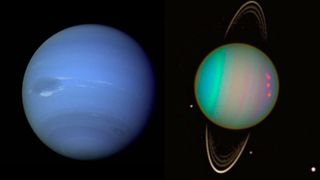How Big is Neptune?
The most distant planet from the sun, Neptune is the third most massive. Despite its great size, it was the last planet to be discovered, because it lies so far away.

Radius, diameter, and circumference
Neptune is the fourth largest planet in terms of diameter, making it the smallest in physical size of the gas giants. The average distance from the center of the planet to its surface is 15,299 miles (24,622 kilometers). But like most spinning bodies, Neptune's rotation causes it to bulge slightly around the equator. The resulting shape is known as an oblate spheroid. The radius at the poles is 15,125 miles (24,341 km), slightly smaller than the equatorial radius of 15,388 miles (24,764 km). The average diameter across the planet is 30,598 miles (49,244 km), almost four times the diameter of Earth.
A trip around Neptune's equator would cover 96,129 miles (154,705 km). Such a trip could not be made on foot—the planet's surface is covered with water and melted ice rather than solid rock.
The planet's surface area covers 2.9 billion square miles (7.6 billion square km).
Like all of the gas giants, Neptune has rings around it. The clumpy arcs extend as far as 39,105 miles (62,933 km) from the center of the planet.
Density, mass, and volume
Although Neptune comes in fourth in terms of diameter, it ranks third in terms of mass, ahead of Uranus. The gas giant weighs in at 1.02 x 1026 kilograms, or 102 trillion trillion kilograms. It is more than seventeen times as massive as Earth.
The rock, ices, and gas that make up the icy giant fill a volume of 15 trillion cubic miles (62 trillion cubic kilometers), almost 58 times the volume of Earth.
The density of Neptune is 1.638 grams per cubic centimeter. The low density indicates that, like Uranus, its atmosphere is made up of more ices than Saturn and Jupiter, causing scientists to call it an "icy giant". The distance to Neptune from the sun keep the planet's temperature low through the year, although some astronomers suspect the planet originally formed closer to the star.
Despite hosting a significantly lower mass, Neptune's surface gravity is second only to Jupiter.
— Nola Taylor Redd, SPACE.com Contributor
Related:
Join our Space Forums to keep talking space on the latest missions, night sky and more! And if you have a news tip, correction or comment, let us know at: community@space.com.
Get the Space.com Newsletter
Breaking space news, the latest updates on rocket launches, skywatching events and more!

Nola Taylor Tillman is a contributing writer for Space.com. She loves all things space and astronomy-related, and enjoys the opportunity to learn more. She has a Bachelor’s degree in English and Astrophysics from Agnes Scott college and served as an intern at Sky & Telescope magazine. In her free time, she homeschools her four children. Follow her on Twitter at @NolaTRedd
